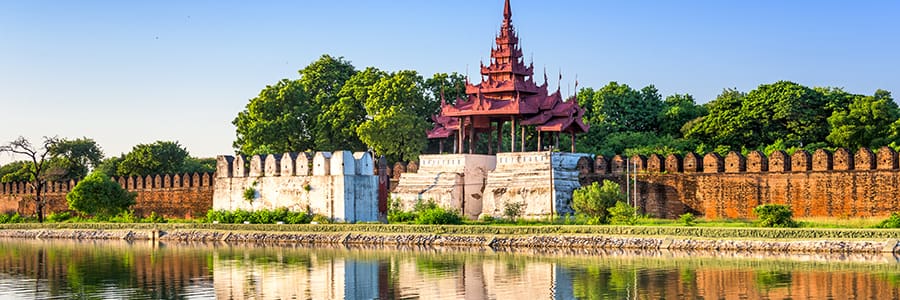
About The Chindwin River
The Irrawaddy may be the “Mother River” of Myanmar, but the wild and unspoiled Chindwin is the country’s pristine heart.
The Chindwin River is the main tributary of the fabled Irrawaddy River, in northern Myanmar, formerly known as Burma. Formed in the Patkai and Kumon mountain ranges of the Indo-Myanmar border, the Chindwin River drains northwest through the Hukawng valley before beginning its 520-mile course southward through the Naga Hills, past pristine forests and unspoiled villages and towns clinging to its banks.
This is about as far off the beaten track as a traveler can go — in fact, up until the Christian missionaries arrived in the 19th century, Nagaland was home to Burma’s infamous headhunters! Today’s traveler is rewarded with vistas of stunning beauty, sailing through dramatic scenery of dense jungles, high cliffs, deep gorges, and remote villages, each with its own unique way of life.
Although the Chindwin is a river less traveled, there are a number of companies offering cruises on the river, many featuring the RV Pandaw Zawagyi, a small ship specially designed with a very low draught, allowing it to pass over the river’s numerous sandbanks to progress upstream as far as Nagaland.
Chindwin River Stats
Length: 750 miles
Depth: Generally shallow depth with numerous sand bars
Source: Hukawng Valley, Kachin State, Myanmar
Mouth: Confluence with Irrawaddy River at Mandalay, Myanmar
Locks: 0
Countries: Myanmar (Burma)
Learn more about the Chindwin River of Asia
The Chindwin River, coursing through the heartland of Myanmar (formerly Burma), is a majestic and enigmatic waterway that weaves its way through the rugged landscapes and remote regions of this Southeast Asian nation. With a length of approximately 1,207 kilometers (750 miles), the Chindwin is the largest tributary of the mighty Irrawaddy River, and it plays a pivotal role in shaping the culture, ecology, and economy of the region. In this narrative, we embark on a journey along the Chindwin, exploring its historical significance, ecological diversity, and the communities that call its banks home.
Geography and Origin
The Chindwin River originates in the mountainous region of northern Myanmar, near the border with India, and flows southwestward before joining the Irrawaddy River near the town of Pakokku. The river’s watershed spans an area of about 90,000 square kilometers (35,000 square miles) and encompasses a wide range of topographical features, from steep mountains to low-lying plains.
Natural Beauty and Biodiversity
The Chindwin River basin is renowned for its stunning natural beauty and rich biodiversity. As it snakes through the dense forests and hills of the Sagaing Region, it offers breathtaking vistas of lush greenery, cascading waterfalls, and serene villages. The river basin is home to an array of wildlife, including numerous bird species, elephants, tigers, and various species of fish. The Chindwin is also a vital habitat for several endangered species, making it a conservation priority for Myanmar.
Historical Significance
The Chindwin River has played a pivotal role in Myanmar’s history, serving as a lifeline for trade, transportation, and cultural exchange. It facilitated contact between the Burmese heartland and the remote regions of the north and northwest, allowing for the exchange of goods, ideas, and cultures. The riverbanks are dotted with ancient temples, monasteries, and historical sites that reflect the diverse influences that have shaped the region over the centuries, from Indian Buddhism to indigenous animist traditions.
Cultural Heritage
The Chindwin River is not only a conduit for trade but also a cradle of culture and heritage. The various ethnic groups inhabiting the river basin, such as the Chin, Naga, Kachin, and Shan, have rich and distinct cultural traditions that are deeply intertwined with the river’s rhythms. These communities have developed unique ways of life and artistic expressions, including traditional music, dance, and craftsmanship, which are passed down through generations.
Economy and Livelihoods
The Chindwin River continues to be an essential source of livelihood for the communities along its banks. Fishing, agriculture, and trade are the primary economic activities in this region. Local fishermen skillfully navigate the river’s currents, casting their nets to catch an abundance of freshwater fish, while farmers cultivate fertile lands nourished by the river’s sediment-rich waters. Timber extraction has also historically been significant in the area, although concerns about deforestation and its environmental impact have led to increased regulation.
Challenges and Conservation Efforts
Despite its natural beauty and cultural significance, the Chindwin River faces numerous challenges. Deforestation, illegal logging, and unsustainable land use practices pose threats to the river’s delicate ecosystem. Additionally, increased development, such as the construction of dams and infrastructure projects, can alter the river’s flow and negatively impact both the environment and local communities. Conservation efforts are underway, with organizations and local stakeholders working to protect the Chindwin’s biodiversity and ensure sustainable management of its resources.
Tourism Potential
In recent years, the Chindwin River has also started to attract attention from tourists seeking to explore Myanmar’s off-the-beaten-path destinations. River cruises and adventure tours offer travelers a unique opportunity to experience the region’s untouched beauty and cultural diversity. These tours not only provide economic benefits to the local communities but also raise awareness about the importance of preserving the Chindwin’s natural and cultural heritage.
